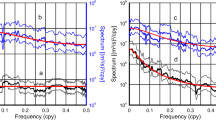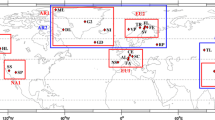Abstract
Spectral analysis is often based on the periodogram and on fitting a first-order autoregressive [AR(1)] process to data as climatological time series generally exhibit red noise spectra that can be well approximated by AR(1) models. When the periodogram exceeds some threshold at a frequency, the spectrum is said to differ from the AR(1) spectrum, and the frequency is generally taken as a member of the discrete spectrum. This traditional technique, however, must not be used without modifications for unevenly spaced data. Our purpose is to provide an AR(1) modeling tool that is more accurate than the TAUEST procedure commonly used for unevenly spaced paleoclimatical records. A periodogram based on an entire least square fit to unevenly spaced data is also introduced instead of the well-known Lomb–Scargle periodogram. The methodology is applied to two paleoclimatological records. Our results compared to those of a frequently used procedure (consisting of TAUEST and Lomb–Scargle periodogram) show some interesting differences.





Similar content being viewed by others
References
Berk KN (1974) Consistent autoregressive spectral estimates. Ann Stat 2:489–502
Box GEP, Jenkins GM (1970) Time series analysis, forecasting and control. Holden Day, San Francisco
Damon PE, Sonnett CP (1991) Solar and terrestrial components of the atmospheric 14C variation spectrum. In: Sonnett CP, Gaimpapa MS, Matthews MS (eds) The sun in time. University of Arizona Press, Tucson
Deeming TJ (1975) Fourier analysis with unequally-spaced data. Astrophys Space Sci 36:137–158
Grenander U, Rosenblatt M (1957) Statistical analysis of stationary time series. Wiley, New York
Groots PM, Stuvier M (1997) Oxygen 18/16 variability in Greenland snow and ice with 10−3- to 105-year time resolution. J Geophys Res 102(C12):26455–26470
Jiang J, Hui YV (2006) Spectral density estimation with amplitude modulation and outlier detection. Ann Inst Stat Math 56:611–630
Kariya T, Kurata H (2004) Generalized least squares. Wiley, Chichester
Kokoszka P, Mikosch T (2000) The periodogram at the Fourier-frequencies. Stoch Proc Appl 86:49–79
Liu JS (2001) Monte Carlo strategies in scientific computing. Springer, New York
Lomb NR (1976) Least-squares frequency analysis of unequally spaced data. Astrophys Space Sci 39:447–462
Matyasovszky I (2010a) Trends, time-dependent and nonlinear time series models for NGRIP and VOSTOK paleoclimate data. Theor Appl Climatol 101:433–443
Matyasovszky I (2010b) Improving the methodology for spectral analysis of climatic time series. Theor Appl Climatol 101:281–287
Mudelsee M (2002) TAUEST: a computer program for estimating persistence in unevenly spaced weather/climate time series. Comput Geosci 28:69–72
Nie J, King JW, Fang X (2008) Tibetan uplift intensified the 400 k.y. signal in paleoclimate records at 4 Ma. GSA Bulletin 120:1338–1344
Nielsen AA (2011) Least squares adjustments: linear and nonlinear weighted regression analysis. Lecture Note, Lyngby, Denmark: IMM, DTU, http://www2.imm.dtu.dk/pubdb/views/publication_details.php?id=2804
Priestley MB (1981) Spectral analysis and time series. Academic, New York
Scargle JD (1982) Studies in astronomical time series analysis II: statistical aspects of spectral analysis of unevenly spaced data. Astrophys J 261:835–853
Schulz M, Mudelsee M (2002) REDFIT: estimating red-noise spectra directly from unevenly spaced paleoclimatological time series. Comput Geosci 28:421–426
Stoica P, Li J, He H (2009) Spectral analysis of nonuniformly sampled data: a new approach versus the periodogram. IEEE Trans Signal Process 57:1415–1425
Stuvier M, Braziunas TF, Grootes PM, Zielinski GA (1997) Is there evidence for solar forcing of climate in the GISP2 oxygen isotope record? Quat Res 48:259–266
Vanícek P (1969) Approximate spectral analysis by least-squares fit. Astrophys Space Sci 4:387–391
Vio R, Adreani P, Biggs A (2010) Unevenly-sampled signals: a general formalism of the Lomb–Scargle periodogram. Astron Astrophys 519:A86–12
Wunsch C (2004) Quantitative estimate of the Milankovitch-forced contribution to observed Quaternary climate change. Quaternary Sci Rev 23:1001–1012
Acknowledgments
The European Union and the European Social Fund provided financial support for the project under the grant agreement no. TÁMOP 4.2.1./B-09/KMR-2010-0003. We thank an anonymous reviewer for helpful comments leading to the final form of the paper.
Author information
Authors and Affiliations
Corresponding author
Appendix
Appendix
It is known (e.g., p. 248 in Priestley 1981) that a stationary stochastic process can be approximated with arbitrary accuracy with a finite set of random amplitude periodic components. Evidently, higher accuracy requires higher number of periodic components. A time series of length n can also be approximated with periodic components, and the highest accuracy of this approximation is achieved when the number of sinusoid and cosinusoid components is \( J = \left\lceil {n/2} \right\rceil \), the feasible highest integer.
Preserving notations used in the previous sections the vector x should be approximated with 2J covariates corresponding to the J number of frequencies satisfying
The least square procedure to estimate c results in the system of linear equations
and has the solution
This is an unbiased estimate of c as
The last equality in Eq. (12) utilizes Eq. (9). These equations hold for the periodogram and ELS periodogram. In the case of the L-S periodogram, only two covariates are used for the J number of frequencies separately. For the jth frequency, the solution of the least square problem is
where subscript 2 refers to the number of covariates, while j refers to the jth frequency. Let \( {\underline {\widehat{c}}_2} = {\left( {\underline c_{{2,1}}^T, \ldots, \underline c_{{2,J}}^T} \right)^T} \) be the L-S estimate of c. Taking the expectation of ĉ 2, similar operations used in Eq. (12) results in \( E\left[ {{{\underline {\widehat{c}} }_2}} \right] \ne \underline c \) (except for evenly spaced data). Hence, the frequency-wise estimation (L-S periodogram) of the sinusoid and cosinusoid coefficients is biased in contrast to the case when the entire set (ELS periodogram) of the sinusoid and cosinusoid coefficients is estimated.
As it was mentioned earlier, every frequency λ j is affected by frequencies not involved in the estimation procedure. Specifically, the right hand side of Eq. (10) is associated not solely with frequencies λ j , but is influenced by the rest of frequencies. Therefore, although ĉ in Eq. (11) would be unbiased if the right-hand side of Eq. (10) were accurate, the ELS periodogram will be biased. The L-S periodogram, however, will introduce an additional bias as shown above.
Rights and permissions
About this article
Cite this article
Matyasovszky, I. Spectral analysis of unevenly spaced climatological time series. Theor Appl Climatol 111, 371–378 (2013). https://doi.org/10.1007/s00704-012-0669-z
Received:
Accepted:
Published:
Issue Date:
DOI: https://doi.org/10.1007/s00704-012-0669-z




